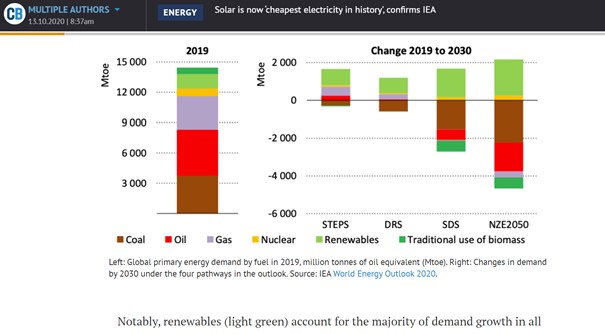Greenpeace Slovenia tweeted via their account on 27 October 2020, claiming that “It’s official now – the solar energy is the cheapest source of energy in history!”. This is mostly true.
Slovenian Greenpeace organization posted on their Twitter account stating that solar energy is from now on officially the cheapest source of energy in history. They included a link to a web article by Popular Mechanics that was their main source. The article itself then refers to another link that refers to a summary by Carbon Brief of a report from IEA’s World Energy Outlook 2020 as the primary source.

When asked about their primary source, Greenpeace Slovenia provided many sources, all confirming their statement. Greenpeace International first posted the claim and they have a high level of trust for the organization and did not further check the source. To confirm the statement, a secondary expert from the Energy Efficiency Centre at Jozef Stefan Institute was contacted. The Centre is mainly oriented in the fields of energy efficiency, RES, reduction of GHG emissions and reduction of air pollutants. Their expert support is employed by Ministries for preparation of strategic and action documents in projects of energy consumption development, making them competent experts to be consulted regarding solar energy.
According to them, the primary source (IEA’s report) is a reliable and trustworthy source to cite from. In the IEA’s report it is stated that solar is now the cheapest form of electricity for utility companies to build. That is due to risk-reducing financial policies around the world and it applies to locations with both the most favorable policies and the easiest access to financing. The statement itself can be a bit problematic, if not interpreted correctly.
Expert opinion
When asked on this topic, Stane Merše an expert from the Jožef Stefan Institute, Energy Efficiency Centre stated: “I think the statement is true, because it cites one of the key studies of IEA’s World Energy Outlook 2020. The article correctly summarizes the main source, on which the claim is based.” However, he warns that with all such short messages, it does not really provide a broader explanation and justification, so it needs to be interpreted correctly. On the one side, due to rapid technological development and a stimulating financial environment, large solar power plants are actually the cheapest new source of electricity globally at the moment, compared to other new large power plants. On the other side however, it is also necessary to be aware of all the limitations of this source, as it is limited in time and unstable, so it can only be used in cooperation with other sources.

Merše continues that IEA results confirm that solar energy being the cheapest is already a dominant global fact (the results confirm this for the world’s largest markets – USA, EU, China and India), but the economics of solar power plants depend mainly on (1) latitude – the closer to the equator, the longer the duration of solar radiation and the lower the costs, and (2) the regulatory framework of countries regarding solar power plants – integration into the grid and electricity market and other incentives are essential.
Our expert explains that, systemically, the method, used by IEA to count the costs of installations of large power plants, does not take into account other costs and impacts caused by technologies in the electricity system, which are certainly higher in solar energy due to instability and time-limited production than in other more predictable technologies. As well as the above mentioned geographical differences and regulatory frameworks implemented but different governments. These additional costs must be taken into account when the future electricity supply is planned systematically. Therefore, each resource has its (limited) role in the system and only with their coherent and optimal integration, lowest cost supply can be achieved.
Solar energy will play an increasing role, but it will necessarily have to be complemented by other low-carbon sources, but the conclusion, that we can provide all the electricity in the future with solar energy would certainly be wrong and problematic concludes Merše and sums up: “The future will certainly be much brighter than today, and in addition to the new capacities of solar power plants, the harmonious development of electricity networks will be crucial.”
Conclusion
In short it can be said that the statement by Greenpeace Slovenia on Twitter that solar energy is from now the cheapest source of electric energy, turned out to be mostly true, but various contextual factors need to be taken into account. Therefore, it is recommended to not always trust in appealing titles, but also to read the full article, make additional research. Often short titles are not able to disclose the full true, as context is a relevant factor and cannot be introduced in 280 or less symbols.
RESEARCH | ARTICLE © Gabriele Viktoria Skerath, Rebeka Sivka, Valentina Tušek, Nina Smole
Leave your comments, thoughts and suggestions in the box below. Take note: your response is moderated.





